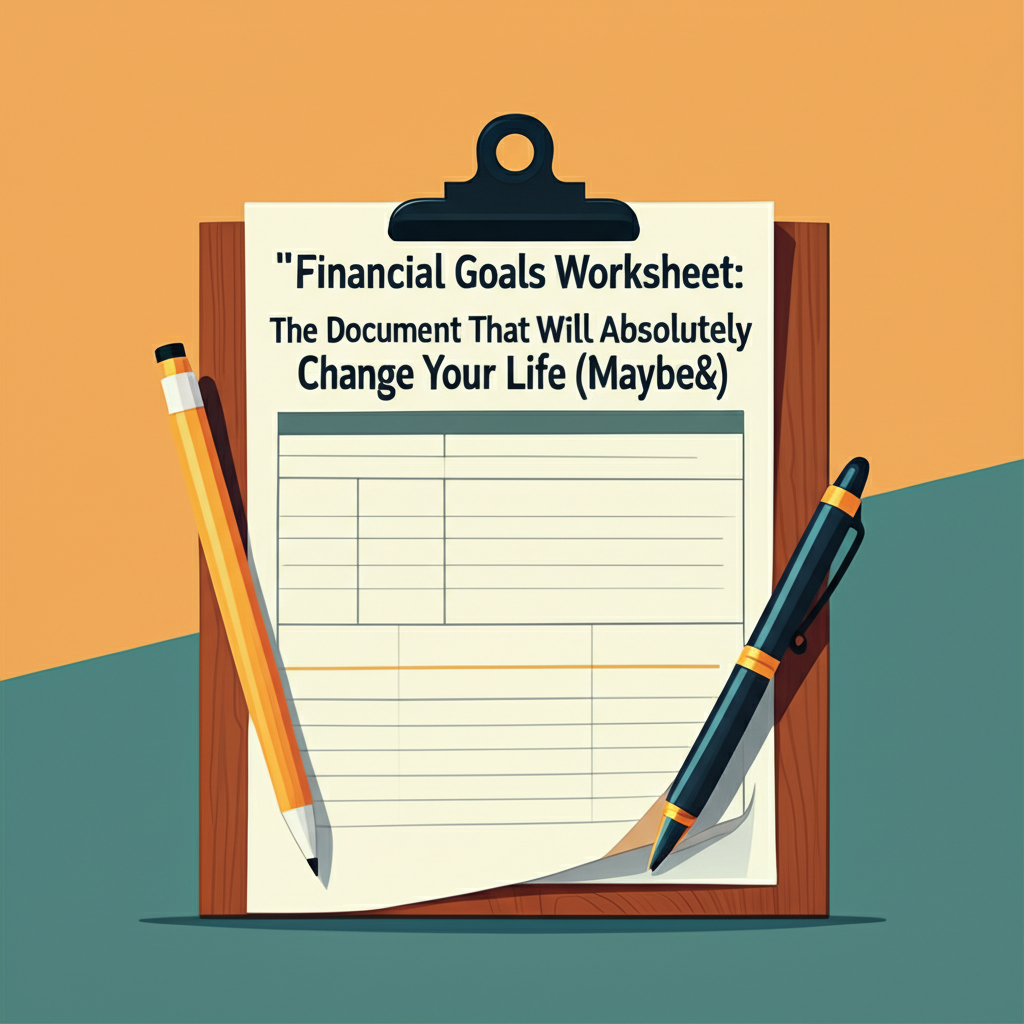
Article 1: "Financial Goals Worksheet: The Document That Will Absolutely Change Your Life (Maybe)"
(Image: A person staring intensely at a financial goals worksheet, with sweat dripping down their forehead and a single tear rolling down their cheek.)
Okay, folks, buckle up! Because today, we’re tackling the Everest of personal finance: The Financial Goals Worksheet. This isn’t just a piece of paper; it’s a portal to a richer, more fulfilling…future? Well, that’s the sales pitch, anyway.
The truth is, for many of us, the Financial Goals Worksheet is less a path to enlightenment and more a painful reminder of our current financial situation. It’s the moment we realize that our dream of owning a yacht shaped like a giant rubber ducky might be…slightly ambitious.
Step 1: Identify Your Dreams (aka The Delusion Stage)
The worksheet usually starts innocently enough: "What are your financial goals?" This is where the fun begins! Write down everything! Early retirement on a tropical island? Owning a fleet of vintage cars? Funding a colony on Mars? The sky’s the limit! (Except, you know, your actual financial limits.)
Step 2: Quantify Your Dreams (aka The Reality Check)
This is where the worksheet turns on you. Suddenly, you have to put a dollar amount on your dreams. That tropical island retirement? Turns out it costs more than you thought. That vintage car collection? Each one is worth more than your house. This is the point where most people quietly crumple the worksheet and go back to binge-watching Netflix.
Step 3: Break Down Your Goals (aka The Humiliation)
Now, the worksheet wants you to break down your goals into smaller, more manageable steps. Suddenly, "early retirement" becomes "save an extra $50 a month by skipping lattes." The yacht shaped like a rubber ducky is replaced with "maybe buy a slightly larger inflatable pool toy."
Step 4: Action Plan (aka The Existential Crisis)
The final step is creating an action plan. This involves things like "creating a budget" (shudder) and "reducing debt" (double shudder). It’s basically a written confession of your financial sins.
In Conclusion (or, The Mildly Depressing Truth)
Financial Goals Worksheets aren’t magic. They won’t magically make you rich. But they can be a useful tool for getting a handle on your finances. Just don’t expect them to be a particularly fun tool. Think of them as the financial equivalent of flossing: You know it’s good for you, but you’d rather be doing literally anything else.
Bonus Tip: Always complete your Financial Goals Worksheet with a large glass of wine. It makes the reality check go down a little smoother.
Article 2: "Financial Goals Worksheet: A Modern-Day Mad Libs for Adults Who Regret Their Life Choices"
(Image: A financial goals worksheet filled out with ridiculous, obviously fake answers.)
Remember Mad Libs? Those fill-in-the-blank stories that always resulted in hilarious, nonsensical outcomes? Well, the Financial Goals Worksheet is basically the adult version. Except instead of filling in nouns and verbs, you’re filling in dollar amounts and dates, and instead of hilarious outcomes, you get crippling anxiety.
Let’s take a look at a typical Financial Goals Worksheet, Mad Libs style:
Financial Goals Worksheet: The Mad Libs Edition
-
My Dream Vacation: To spend [a large sum of money] on a trip to [a fictional planet] where I will [verb ending in -ing] with [a plural noun].
-
My Retirement Goal: To retire at age [a ridiculously low number] with [an even more ridiculous sum of money] in my bank account so I can spend my days [doing something incredibly lazy] and [something even lazier].
-
My Emergency Fund Goal: To have [a laughably small amount of money] saved in case of [a truly bizarre emergency], like [a celebrity randomly needing my help] or [my pet suddenly becoming fluent in a foreign language].
-
My Debt Reduction Plan: To magically eliminate my [a large number] of dollars in debt by [a completely unrealistic method], such as [winning the lottery] or [discovering a hidden treasure chest].
The Result:
After filling in the blanks, you’ll have a Financial Goals Worksheet that’s either wildly optimistic or hilariously depressing. Either way, it’s probably not entirely realistic.
The Real Takeaway:
While the Financial Goals Worksheet might seem like a joke, it’s important to remember that having financial goals, even slightly unrealistic ones, is better than having no goals at all. So, go ahead, fill out that worksheet. Embrace the absurdity. And maybe, just maybe, you’ll end up with a slightly clearer picture of your financial future.
Just remember to fill it out with a sense of humor. You’ll need it.
Article 3: "Confessions of a Financial Goals Worksheet: What I Really Think About Your Spending Habits"
(Image: A cartoon Financial Goals Worksheet with a smug expression.)
Okay, I’m a Financial Goals Worksheet. I’ve seen it all. I’ve been filled out with meticulous detail, crumpled in frustration, and even used as a coaster for a lukewarm cup of coffee. And frankly, I have some things to say.
To the Person Who Spends More on Coffee Than on Retirement:
Honey, I see you. I see that $5 latte every morning. I see that "treat yourself" mentality. And I’m here to tell you that while I admire your dedication to caffeine, your future self is going to be living on ramen noodles and regret. Seriously, put down the latte and pick up a savings account.
To the Person Who Thinks ‘Emergency Fund’ Means ‘New Shoes Fund’:
An emergency fund is for emergencies, not for that pair of designer shoes you saw on Instagram. A flat tire is an emergency. A sudden dental bill is an emergency. A craving for overpriced footwear is not. Get your priorities straight.
To the Person Who Thinks Credit Card Debt Will Magically Disappear:
Newsflash: it won’t. Credit card debt is like a clingy ex. It just keeps coming back, no matter how hard you try to ignore it. The only way to get rid of it is to face it head-on and start paying it down.
To the Person Who Has Absolutely No Idea What They’re Doing:
Don’t worry! You’re not alone. Personal finance is confusing. But that’s why I exist! Use me as a starting point. Research your options. Talk to a financial advisor. Just don’t bury your head in the sand and hope for the best.
My Final Message:
I’m just a piece of paper. I can’t magically fix your finances. But I can help you get organized, set goals, and track your progress. So, give me a chance. You might be surprised at what you can achieve. And please, for the love of all that is holy, stop using me as a coaster.
I hope these articles are helpful and humorous! Remember to adapt them to your specific audience and style. Good luck!


Post Comment